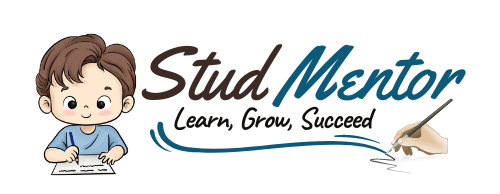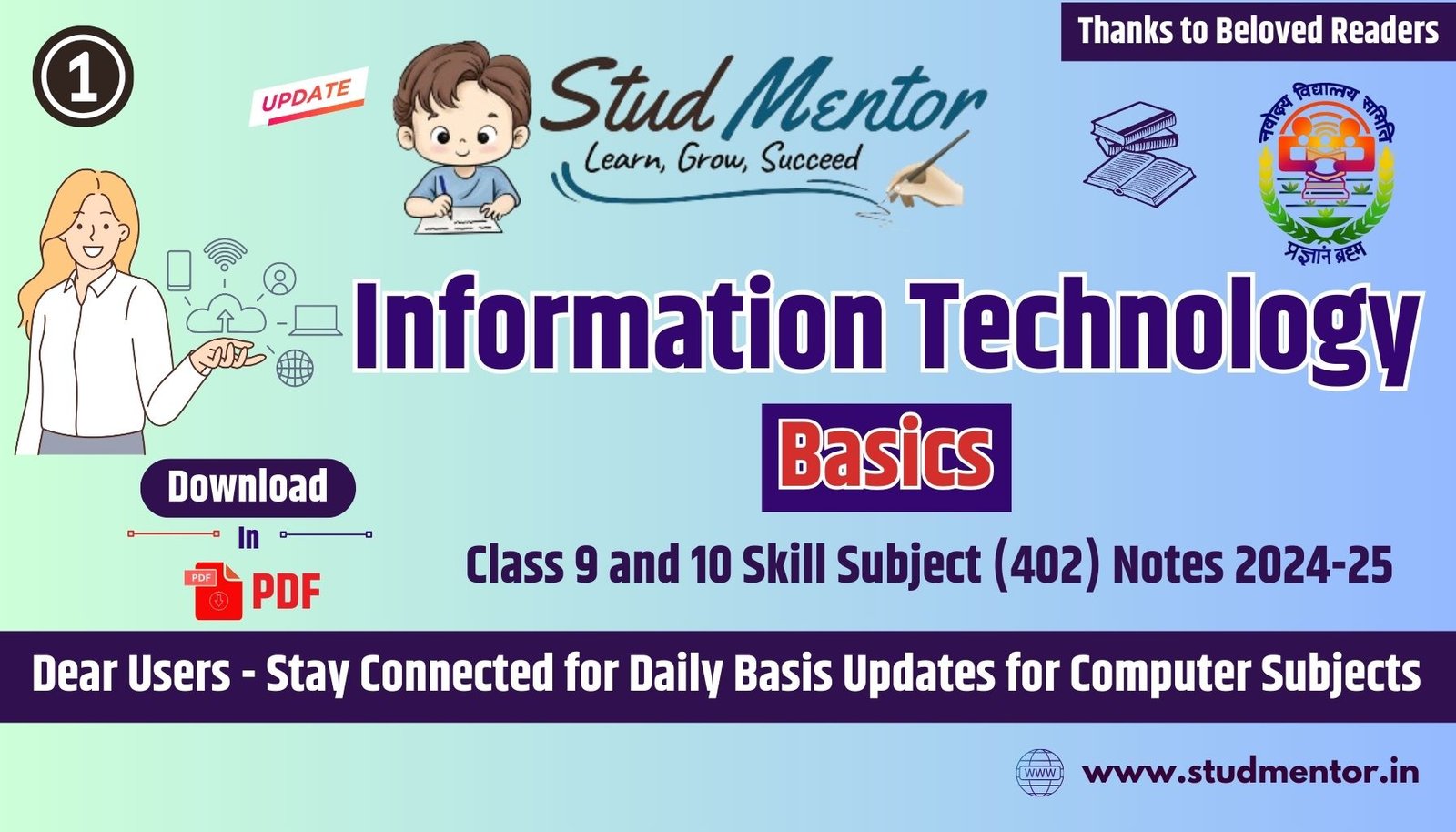In this article we providing information regarding latest Basics of Information Technology Class 9 and 10 Skill Subject Notes.
Basics of Information Technology – Class 9 and 10 Skill Subject Notes
We are giving complete information and Syllabus of IT in this Website So Be Connected.
What is IT ?
Information technology (IT) is the use of computer systems or devices to access information.
What Are the Types of Information Technology?
Information technology is a broad term that involves the use of technology to communicate, transfer data and process information.
The different trends within information technology include, but aren’t limited to:
- Analytics
- Automation
- Artificial intelligence
- Cloud computing
- Communications
- Cybersecurity
- Data/database management
- Infrastructure
- Internet of things
- Machine learning
- Maintenance and repair
- Networks
- Robotics
- Software/application development
Computer System : Characteristics of a computer, components of a computer system – CPU, memory, storage devices and I/O devices
Memory – Primary (RAM and ROM ) and secondary memory
Storage devices – Hard Disk, CD ROM, DVD, Pen/Flash Drive, Memory Stick
I/O Devices – Keyboard, Mouse, Monitor, Printer, Scanner, Web Camera
Types of Software – System Software (Operating System, Device Drivers). Application Software including mobile applications
Computer Networking – Type of networks : PAN, LAN, MAN, WAN, wired / wireless communication, Wi-Fi, Bluetooth, cloud computers (private/public)
Multimedia – Images, Audio, Video, Animation
1. Computer System
Computer Basics
Definition : The computer is an electronic device. It is known as an electronic device because it runs through electricity. It takes input, processes it and gives desired results. The results of the computer system are also known as output.
The basic structure of the computer system is as follows –
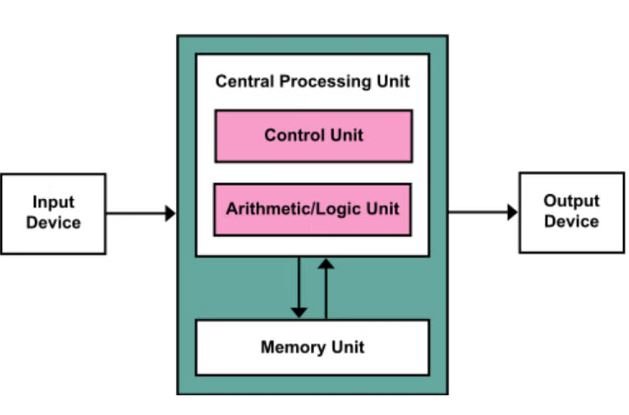
Three major devices help to run the computer system smoothly.
Characteristics of a Computer system
Characteristics of a computer system let us know about its capabilities. The followings are the key characteristics of the computer system.
Speed
- The Computer is a much faster device
- Can solve very complex problems faster than a person.
- It gives results within a second
- Computer can solve multiple problems within very less time
Data Storage
- Can store a large amount of data for a long time period
- The data can be store in internal as well as external devices.
- The internal device of data storage is hard disk and external storage devices are Pen Drive, External Hard Disk, etc.
Accuracy
- Computers can generate reliable results with high computational speed.
- If the input is right then only the appropriate output will be generated.
- The computer never gives inaccurate results; if results are inaccurate it means inputted data erroneous.
Versatility
A computer is a versatile machine that can perform different types of jobs with same accuracy rate.
Diligence
- Computers never get tired.
- As humans get tiers when he works regularly but the computer can perform tasks over and over again, with the same outcome, and it does so without tiring.
No IQ
It performs a task that is exactly as directed by the user because it does not have its intelligence.
Reliable
Consistency refers that a computer is a reliable machine, as it always gives consistent results.
2. Memory
- Memory is a storage device of a computer system.
- This device is used to store data/information
- As per user’s need and the advancements in the computer industry, the manufacture’s developed advanced memory devices which can execute data speedily and can store large size data.
- In computer, the nature of data storage is into two forms i.e. temporary and permanently.
- Temporary storage is needed mostly at execution time.
- While the permanent store is needed after the execution of the programs when the user wants to save results permanently for future reference.
Input Device
- The computer takes input through input devices.
- It accepts data and instruction from the outside worlds.
- It converts these data and instruction into computer understandable from binary form.
- It supplied the converted data and instruction to the computer system for further processing.
- The most popular input devices are mouse, keyboard, joystick, microphone, camera, etc.
Processing Device
- CPU (Central Processing Unit) is a processing device.
- CPU is the brain or the heart of a computer. It is also known as processor and consist of three units namely –
- Control Unit (CU)
- Arithmetic Logic Unit (ALU)
- Main Memory Unit
- Microprocessor fixed inside it which processes data inputted by users input devices.
Output Device
- These are the devices that show processed results or messages to the user.
- The most popular output devices are Monitor and Printer.
- The monitor shows computer instructions and output in the form of soft contents.
- While the printer prints the desired results on paper.
- If the user wants to keep records then they prints it otherwise saves computerized contents in computer memory and uses these contents whenever they require .
1. Memory Unit
- Memory is also known as the storage medium of the computer system. This is a storage device that can store data/information. Memory is primarily categorized into two parts:
- Primary Memory :
- This is also known as the main memory or temporary memory or volatile memory. This memory device stores data for a temporary period. Programs or Instructions execute in Primary Memory.
- Primary memory further categorized into two parts –
- RAM (Random Access Memory)
- ROM (Read Only Memory)
- Secondary Memory :
- Secondary memory is a memory that can store a large amount of data in it. Once, data is saved into secondary cannot delete until and unless the user’s permission. It is also known as a permanent memory.
- Primary Memory :
2. ALU
- ALU stands for the Arithmetic and Logical Unit
- This is an important element of the computer system which is used to perform arithmetic and logical operations.
- ALU is a part of a computer processor.
3. Control Unit
- Control Unit controls all the devices connected to the computer system so that interrupt or unavoidable circumstances between device communications cannot happen.
- CU not only controls device communication but also program executions.
- CU mainly communicates between processor, memory and computer peripherals(input/output devices)
4. Storage Unit
Storage devices are the computer hardware used to remember/store data.
The different storage devices are :
- Hard Drive – An Internal Hard Drive is the main storage device in a computer. An external hard drive is also known as removable hard drive. It is used to store portable data and backups.
- CD ROM Disc – An optical storage device that is read – only or cannot be modified or deleted.
- DVD-R, DVD+R,DVD-RW and DVD+RW disc – DVD-R and DVD+R are recordable discs that can be written to once, while DVD-RW and DVD+RW are rewriteable discs that can be written to multiple times. The difference between the + and – is the formatting and compatibility.
- USB Flash Drive, Jump Drive or Thumb Drive – A small, portable storage device connected through the USB Port.
- Memory Stick – A memory card that is removable.
5. Hardware and Software
- Hardware is the tangible components of the computer system which can be used to give input, store data and showing results.
- The popular hardware are mouse, keyboard, monitor, printer, processor, motherboard, cables etc.
- Software is a program or set of instructions used to do a specific task.
- The software cannot be seen by users. Users can realize and validate their functions only.
- All the software run on the hardware.
3. Input /Output Devices
I/O devices are the pieces of hardware used by a human (or other system) to communicate with a computer.
Keyboard
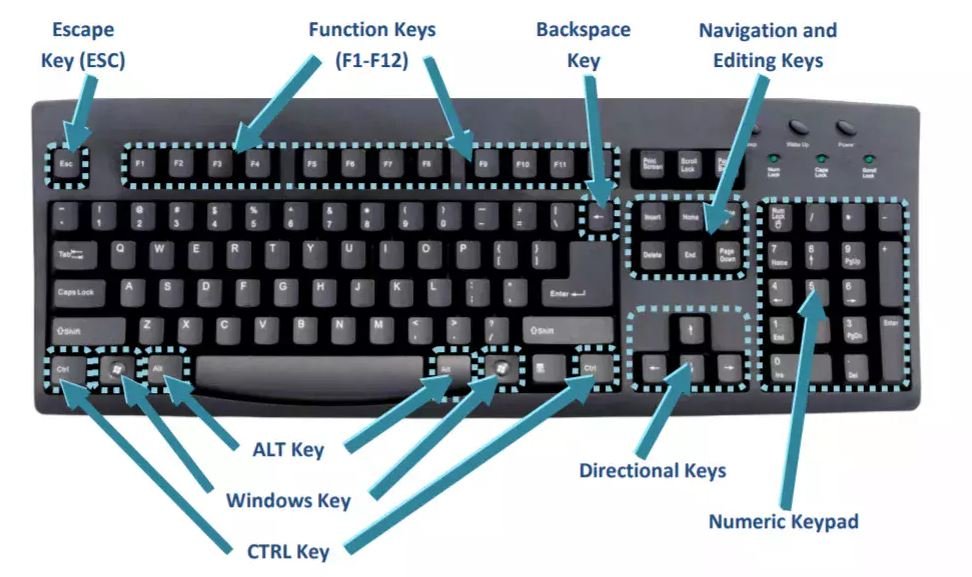
- It is the most commonly used input device.
- It is used to enter data and instructions directly into the computer.
- There are 104 buttons on the keyboard which are called keys.
Mouse
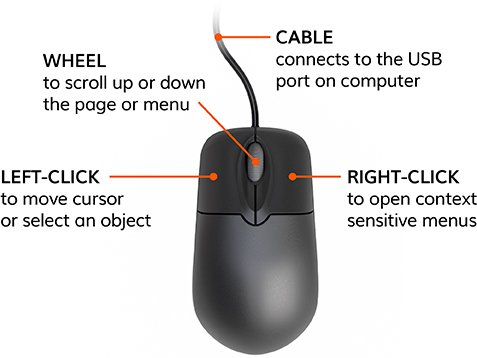
- It is another input device which is commonly found connected with the computers.
- It is basically a pointing device which works on the principle of Point and Click.
- When the mouse is moved on the mouse pad, a light beam underneath reflect to give motion to the pointer on the screen.
Scanner
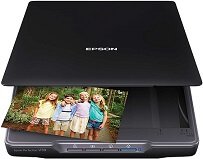
We can store pictures, photographs, diagrams into the computer with the help of scanner. The scanner reads the image and saves it in the computer as a file.
Monitor
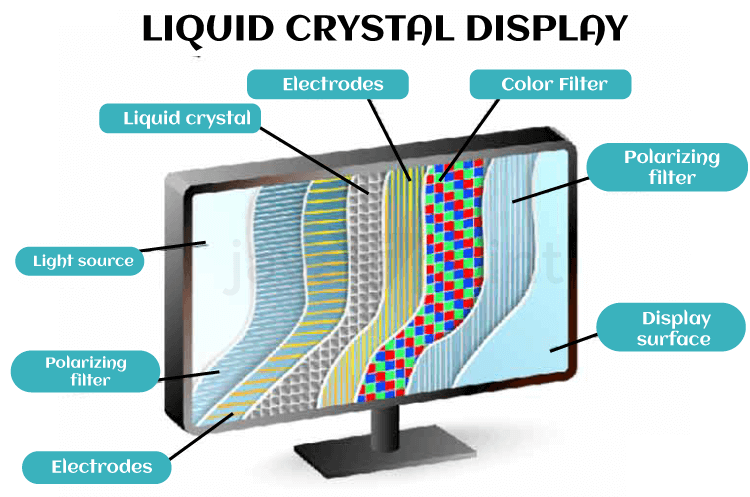
- This is the most common output device connected with the computer to display the processed information.
- It looks like a TV and is also know as VDU (Visual Display Unit)
- Pictures are displayed by using a large number of very small dots on screen called pixels.
- The number of pixels that a monitor can show on its screen is referred to as the resolution of the screen.
Printer
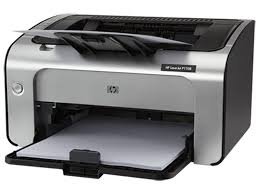
- This is an important output device of the computer system.
- It gives a printed output of the results that appears on the monitor screen.
- Printed output is also called Hard Copy output because unlike monitor, this output can be preserved even if the computer is switched off.
Plotter
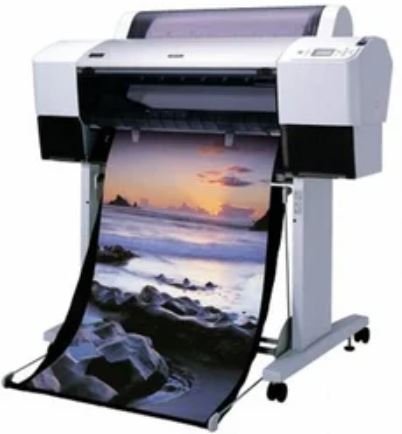
- We can get the print of a photograph, drawing, image stored in the computer by using a plotter.
- It is an output device which provides a high quality of printed output. It is generally used by engineers and architects.
4. Types of Software
- System software is a software that provides platform to other software.
- System software includes the programs that are dedicated to managing the computer itself, such as the operating system, file management utilities, and disk operating system(or DOS)
- Some examples can be operating system, antivirus software, disk formatting software, computer language translators etc.
Operating System
- An operating system is a type of system software that manages computer’s hardware and software resources.
- It provides common services for computer programs. An OS acts a link between the software and the hardware.
Application Software
- These are designed to perform a specific task or a bunch of tasks.
- They can be user-designed (specific to the user’s needs) or readymade application software.
- Example : PowerPoint, Tally etc.
5. Computer Networking
A computer network is a system in which multiple computers are connected to each other to share information and resources.
Characteristics of Computer Network
- Share resources from one computer to another.
- Create files and store them in one computer, access those files from the other computer connected over the network.
- Connect a printer, scanner, or a fax machine to one computer within the network.
Types of Network
- LAN – Local Area Network
- PAN – Personal Area Network
- MAN – Metropolitan Area Network
- WAN – Wide Area Network
LAN (Local Area Network)
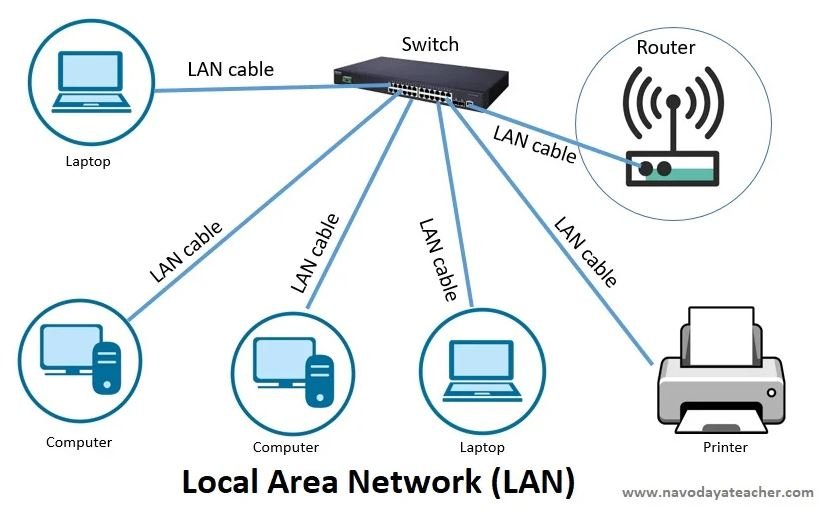
- Local Area Network is a group of computers connected to each other in a small area such as building, office.
- LAN is used for connecting two or more personal computers through a communication medium such as twisted pair, coaxial cable etc.
- It is less costly as it is built with inexpensive hardware such as hubs, new adapters, and ethernet cables.
- The data is transferred at an extremely faster rate in Local Area Network. Local Area Network provides higher security.
PAN – Personal Area Network
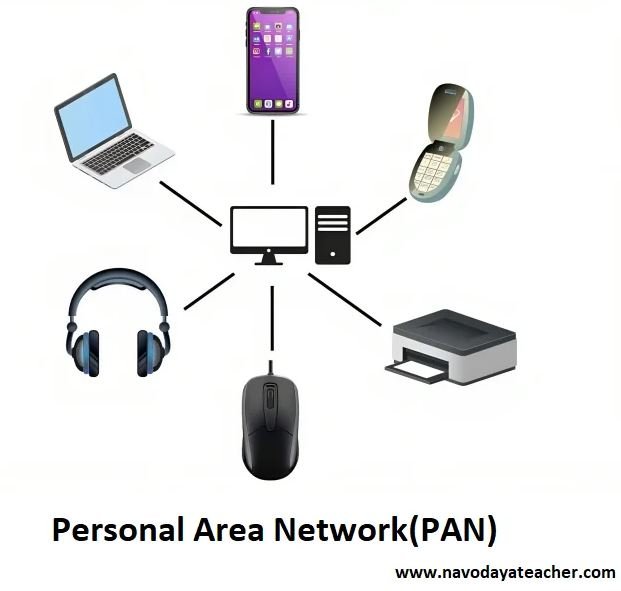
- Personal Area Network is a network arranged within an individual person, typically within a range of 10 meters.
- Personal Area Network is used for connecting the computer devices of personal use is known as Personal Area Network.
MAN – Metropolitan Area Network
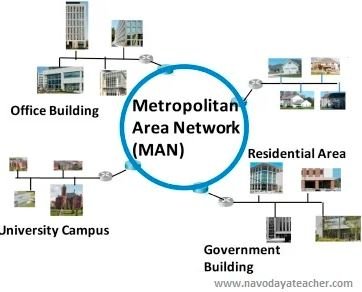
- A Metropolitan area network is a network that covers a larger geographic area by interconnecting a different LAN to form a larger network.
- Government agencies use MAN to connect to the citizens and private industries.
- In MAN , various LANs are connected to each other through a telephone exchange line.
- It has a higher range than Local Area Network (LAN)
WAN – Wide Area Network
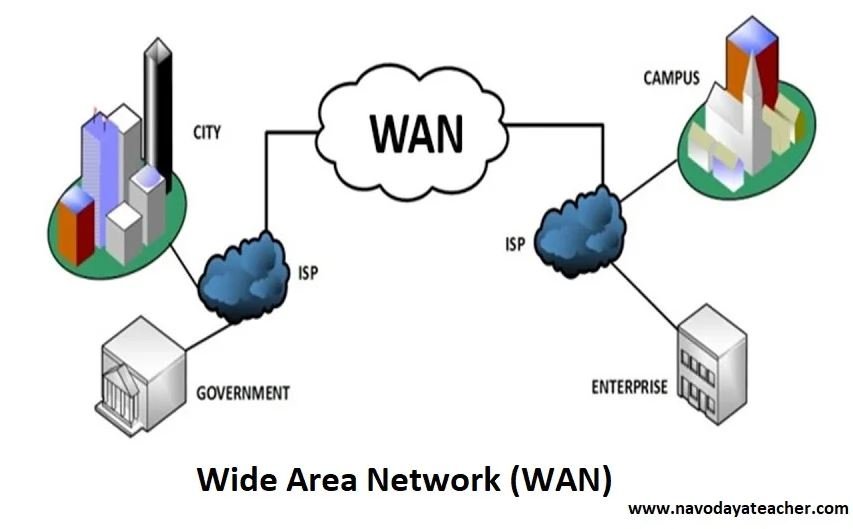
- A Wide Area Network is a network that extends over a large geographical area such as states of countries.
- A Wide Area Network is quite bigger network than the LAN.
- A Wide Area Network is not limited to a single location, but it spans over a large geographical area through a telephone line, fibre optic cable or satellite links.
- The Internet is one of the biggest WAN in the world.
- The Wide Area Network is widely used in the field of Business, Government, and Education.
Wireless Communication Technology
Wireless Communication Technology is categorized into different types depending on the distance of communication, the range of data and types of devices used. The following are the different types of wireless communication technologies.
Wi-Fi (Wireless Fidelity)
- It is low-cost wireless communication technology.
- A Wi-Fi setup consists of a wireless router which serves a communication hub, linking portable device with the internet connection.
Bluetooth Technology
- It allows you to connect a variety of different electronic devices wirelessly to a system for the transfer and sharing of data and this is the main function of Bluetooth.
- Cell phones are connected to hands-free earpieces, wireless keyboard, mouse and mike to laptops with the help of Bluetooth as it transmits information from one device to other device.
- Bluetooth technology has many functions, and it is used most commonly in wireless communication’s market
Cloud Computing
Cloud computing is the delivery of on-demand computing services from application to storage and processing power typically over the internet and on a pay as you go basis.
Multimedia
Multimedia means that computer information can be represented Or Computer Controlled integration of Text, Graphics, Drawings, Still and Moving images (Video), animation, audio, and any other media.
Thanks to Beloved Readers.
